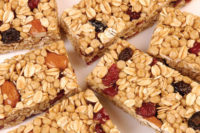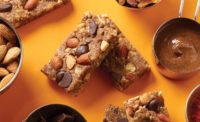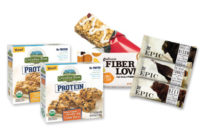In many ways, snack bars are the ultimate snack: convenient, nutritious, and satisfying. Although not a substitute for a full meal, they’re a great way for consumers to tide themselves over when they’re looking for an energy boost.
And now, snack bar manufacturers are going above and beyond to deliver bars with more nutrition and better ingredients. Manufacturers understand that consumers want cleaner nutritional profiles in their food. The more ingredients they can pronounce, the better they feel.
“Consumers are looking for a simpler ingredient list that harkens back to things you might find in grandma’s pantry,” says Carol Lowry, senior food scientist, Cargill. “That’s the challenge facing product developers: How can you be innovative and still stay within those simple ingredients?”
At Skinnygirl, they focus on creating products with all-natural flavors and ingredients, using no artificial sweeteners. They use organic cane sugar and try to find natural sources for anything they put into their bars, says Jessica Lau, brand manager. And it all comes out to about 150 cal. per bar.
Most importantly, they try to make their products taste great.
“We find ways to make sure the flavors of the bar are decadent and tasty enough to feel like a dessert you’re indulging in, but without feeling the guilt that’s associated with eating desserts,” says Lau.
Skinnygirl’smost popular product is the Chocolate Peanut Butter Sea Salt bar, which Lau says tastes exactly like a chocolate bar, but with protein and fiber to satisfy the customers who are looking for something beyond just taste.
Flavors like that appeal to Skinnygirl’s wide-ranging female demographic.
“We’re making products for women who know what they want and kind of want it all,” says Lau. “So they don’t feel like they need to choose between being healthy and also satisfying themselves.”
Clif Bar & Co. similarly understands consumers’ desire for recognizable ingredients. That’s why 70 percent of the company’s ingredients are organic, and many of their products address special health concerns. Luna bars, for example, are now gluten-free, allowing consumers who have celiac disease or are gluten-intolerant to indulge on snack bars. The company also has reduced the sugar content in Luna bars by 25 percent.
But what’s really starting to take off are savory flavors and unexpected combinations.
Mediterra, which makes bars based on the Mediterranean diet, uses ingredients found in the Mediterranean region such as sundried tomato, olive oil, pistachios, and green olives to create its flavors.
And the company recently added two new flavors to its savory line: Kale/Pumpkin Seeds and Bell Peppers/Green Olives. These new flavors, containing one and two grams of sugar respectively, are rich in vegetables, nuts, herbs and seeds. They also contain protein-rich pea crisps, amaranth and olive oil.
“These are the first truly savory bars by ingredients, not just by seasoning,” says Paul Pruett, ceo.
The drive to create new and fascinating flavors has led to the birth of new brands as well. Abbott Laboratories, a global health care company, recently launched the new snack brand Curate, which take a culinary approach to snacking by creating flavor combinations meant to taste like they were handcrafted by a chef.
Their bars include blends of ingredients consumers would be able to find in grocery stores, including Mission figs, balsamic vinegar, quinoa, chia seeds, and elderberry. They’re a good source of plant-based fiber and are made without artificial preservatives, flavors, or colors.
Curateis launching with six flavors, all of which combine natural ingredients to create interesting profiles. Balsamic vinegar, fig, and hazelnut with orange citrus zest make up the Dark & Tempting bar. The Harmonious Blend features Marcona almond and apricot with hints of lemon, vinegar, quinoa, and honey.
“I often hear from people that they would love to make their own snack bars, but they simply don’t have the time,” says culinary nutritionist Katie Cavuto, MS, RD. “Curate bars are a great alternative to a homemade snack and they contain plant-based fats and are a good source of fiber. Plus, each bar comes in under 200 calories and boasts around the same amount of protein as one medium-sized egg. The unique sweet and savory flavor composition paired with the bar’s impressive nutrient profile creates a satisfying snack and helps to minimize less nutritious, impulse snack choices.”
And, they appeal to more adventurous consumers looking to try something new.
“Even with countless nutritious snack options in store, people told us they still weren’t quite satisfied and were often looking to make their own snacks using ingredients from their kitchen,” says Dustin Finkel, general manager, Nutritious Snacks, Abbott. “We saw this as an opportunity to create a snack brand that tastes handcrafted, with rich textures and flavors you would expect from a chef and blends of ingredients you can find in nearly every grocery or natural food store.”
Of course, two of the biggest trends across all food categories, including bars, are protein and clean label, says Lowry. But it’s important to create a positive eating experience for the customer.
“When working with protein, flavor can be a challenge, especially some of the newer protein sources,” she says. “The key is to design the product’s flavor profile around the protein source. Rather than try to mask it, opt for a savory flavor that works in synergy with the protein’s natural flavor.”
One such new protein source is meat. Although bars traditionally use dairy-based proteins like whey or plant-based proteins like soy, animal sources like lamb, beef, chicken, and bacon are beginning to attract consumers’ attention.
“General Mills’ recent purchase of meat bar pioneer Epic is a sure sign that what was once considered a niche product is gaining mainstream appeal,” Lowry adds. “Also in the protein segment, there’s a growing interest in pulses like beans and lentils, and on the very cutting edge, a few companies are experimenting with insects.”
Ultimately, says Lowry, the snack bar market is highly fragmented. There’s a bar for every need and every part of the day.
So the challenge is to create products with wide appeal to multiple segments or to innovate with new products in an established brand.
And with the push toward cleaner labels, it’s important to remember: it’s all about transparency.












